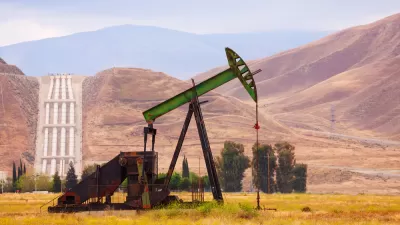Until recently, California's Monterey Shale was estimated to have the nation's highest amount of recoverable oil. Then the Energy Department revised their estimates, lowering it 96%, which turned out to be bad news for fracking moratorium advocates.
Fracking opponents may have been greatly relieved by the downward revision of the Monterey Shale oil reserves by the Energy Information Administration (EIA) last May from 13.7 billion barrels to 600 million barrels, but from a moratorium perspective, it "may have helped the case for regulating instead of banning fracking," reports Governing staff writer Chris Kardish.
Opponents have long concerned with fracking's potential to contaminate and exhaust precious groundwater supplies during one of the state's worst recorded droughts and stimulate earthquakes as has been shown in Ohio. They were dissatisfied with the passage of the "Nation's Toughest Fracking Bill" (SB 4) last September, but were unsuccessful in passing moratorium legislation this year.
Making the case against the moratorium was Sen. Andy Vidak (R-Hanford) who represents parts of Kern County which "produces approximately 75% of California’s in-state oil and about 58% of the state’s total natural gas," according to the Greater Bakersfield Chamber of Commerce.
Vidak say the moratorium would’ve cost jobs --“thousands and thousands” of jobs. Vidak says the potential in Kern County and across the Monterey is huge, even with the lower estimate, because the same technological improvements that made fracking widespread will continue.
Making the case for the revision being good for regulation, bad for moratorium is Thad Kousser, a political science professor at the University of California, San Diego.
(T)he downgrade in estimated reserves has actually allayed some concerns about California becoming overrun with fracking operations, says Kousser. Californians are also happy to let the industry go about its business safely as long as they believe regulators have put the right guidelines in place, he says. “California is a state that, even though nationally we are looked at as environmental leaders, has always taken a ‘regulate but don’t ban’ position on the environment.”
No doubt that won't stop fracking opponents who have vowed [PDF] to try again with new moratorium legislation. However, Kardish writes that "Gov. Jerry Brown and some other state Democratic leaders support fracking." And Brown's Republican opponent in the November gubernatorial election, Neel Kashkari, is a major fracking booster.
FULL STORY: California Has a Lot of Fracking but Only a Little Oil

Maui's Vacation Rental Debate Turns Ugly
Verbal attacks, misinformation campaigns and fistfights plague a high-stakes debate to convert thousands of vacation rentals into long-term housing.

Planetizen Federal Action Tracker
A weekly monitor of how Trump’s orders and actions are impacting planners and planning in America.

San Francisco Suspends Traffic Calming Amidst Record Deaths
Citing “a challenging fiscal landscape,” the city will cease the program on the heels of 42 traffic deaths, including 24 pedestrians.

Defunct Pittsburgh Power Plant to Become Residential Tower
A decommissioned steam heat plant will be redeveloped into almost 100 affordable housing units.

Trump Prompts Restructuring of Transportation Research Board in “Unprecedented Overreach”
The TRB has eliminated more than half of its committees including those focused on climate, equity, and cities.

Amtrak Rolls Out New Orleans to Alabama “Mardi Gras” Train
The new service will operate morning and evening departures between Mobile and New Orleans.
Urban Design for Planners 1: Software Tools
This six-course series explores essential urban design concepts using open source software and equips planners with the tools they need to participate fully in the urban design process.
Planning for Universal Design
Learn the tools for implementing Universal Design in planning regulations.
Heyer Gruel & Associates PA
JM Goldson LLC
Custer County Colorado
City of Camden Redevelopment Agency
City of Astoria
Transportation Research & Education Center (TREC) at Portland State University
Jefferson Parish Government
Camden Redevelopment Agency
City of Claremont



























